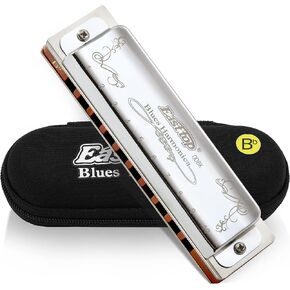- Shopping, made easy.
- /
- Get the app!
ABOUT THIS ITEM: Lucky 13 Designer BRENDAN POWER Explains…
The extended length of the Lucky 13 lends itself well to harmonica tunings that repeat every four holes, since they require extra holes to achieve the same 3 octave range as Richter does in a 10-hole harp.
SOLO TUNING is the best known of these. It is used on 99% of chromatic harmonicas sold, so many players will be familiar with it.
An excellent tuning for playing pop melodies, it's also great for playing 3rd Position Blues and Celtic music. It's actually exactly the same scale as on holes 4-7 on a standard Richter diatonic, so all harp players will instantly feel at home with it. Solo simply repeats that pattern throughout the harp.
My Lucky 13 in Solo Tuning comes in the keys of C, G and D. It's half-valved, to give strong, expressive blow notes as well as bendable draw notes on the odd-numbered holes. I chose the popular Orchestra variant of Solo Tuning, where the scale starts a fifth below the tonic note.

 East top Diatonic Harmonica Key of A 10 Holes 20 Tones 008K Blues Diatonic Mouth Organ Harmonica with Silver Cover, Standard Harmonicas For Adults, Professionals and Students
KWD 10.500
East top Diatonic Harmonica Key of A 10 Holes 20 Tones 008K Blues Diatonic Mouth Organ Harmonica with Silver Cover, Standard Harmonicas For Adults, Professionals and Students
KWD 10.500
 -10%
East top 24 Holes Tremolo Harmonica Key of C, Tremolo Mouth Organ Harmonica for Adults, Professionals and Students (T2406K-C)
KWD 13.500
-10%
East top 24 Holes Tremolo Harmonica Key of C, Tremolo Mouth Organ Harmonica for Adults, Professionals and Students (T2406K-C)
KWD 13.500
 East top Blues Harmonica, Diatonic Harmonica Key of C 10 Holes 20 Tones Mouth Organ blues harp harmonica For Adults, Kids, Beginners, Professionals and Students (Red)
KWD 3
East top Blues Harmonica, Diatonic Harmonica Key of C 10 Holes 20 Tones Mouth Organ blues harp harmonica For Adults, Kids, Beginners, Professionals and Students (Red)
KWD 3
 -10%
East top Harmonica, Forerunner Chromatic Harmonica C Key 12-Hole 48 Tones Chromatic Mouth Organ Harmonica for Adults, Chromatic Harmonica Key of C for Beginners and Students
KWD 49.500
-10%
East top Harmonica, Forerunner Chromatic Harmonica C Key 12-Hole 48 Tones Chromatic Mouth Organ Harmonica for Adults, Chromatic Harmonica Key of C for Beginners and Students
KWD 49.500